Come to the exhibition if you’re near Dundee on a Friday afternoon in June!
Throughout June, a selection of Binary Bonsai, Fibonacci Flowers and Hyperbolic Chanterelles will be on display in the
D’Arcy Thompson Zoology Museum
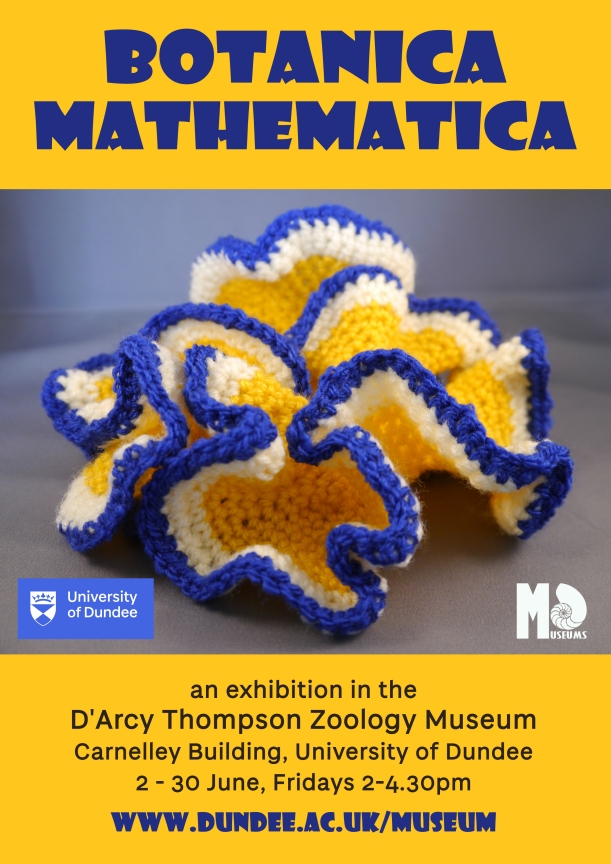

Come to the exhibition if you’re near Dundee on a Friday afternoon in June!
Throughout June, a selection of Binary Bonsai, Fibonacci Flowers and Hyperbolic Chanterelles will be on display in the
D’Arcy Thompson Zoology Museum

Sign up here to be sure of a place on the Binary Bonsai knitting workshop.
On the afternoon of Sunday 18 June, we’ll be knitting little binary trees and hyperbolic chanterelles and crocheting hyperbolic flowers and fungi in the D’Arcy Thompson Museum, University of Dundee (location map on the sign up page).
All materials will be provided, as well as the tools to get you started – courtesy of Fluph Shop. Please bring your own set of double pointed needles so that you can take an unfinished Binary Bonsai home easily.
The workshop will take place within Museum itself so you’ll be able to see the Botanica Mathematica exhibition in full at the same time.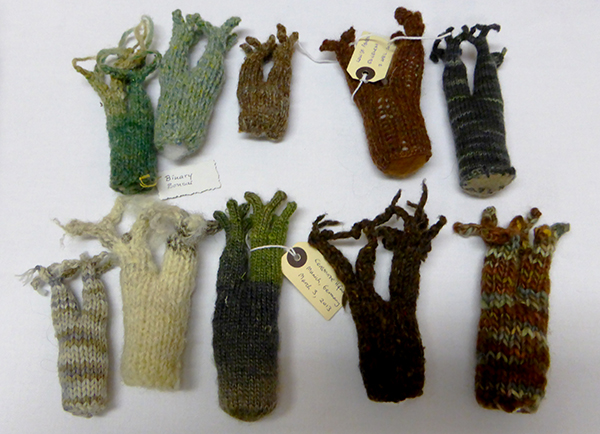
Botanica Mathematica is finally coming to an end this year. We’re marking it with return to Edinburgh International Science Festival where this project began in 2013 and an exhibition and workshop in the D’Arcy Thompson Museum in the University of Dundee in June. We’ll be showing off all the trees and other specimens we’ve collected over the four years of the project complete with the classification scheme, our family tree of trees.
The D’Arcy Thompson Museum seems a very fitting place to wind up this textile exploration of form and taxonomy and move on to new projects. There is, however, still a chance that more might happen later in the year. Keep checking back for more announcements.
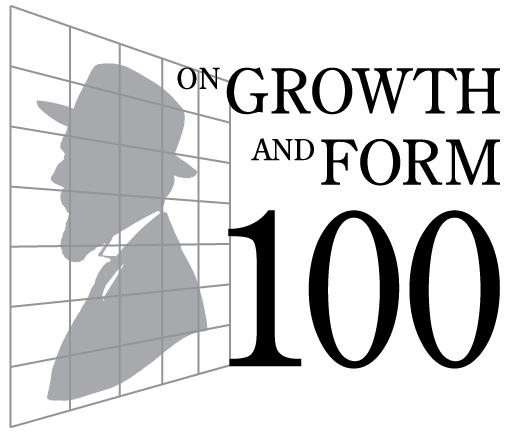
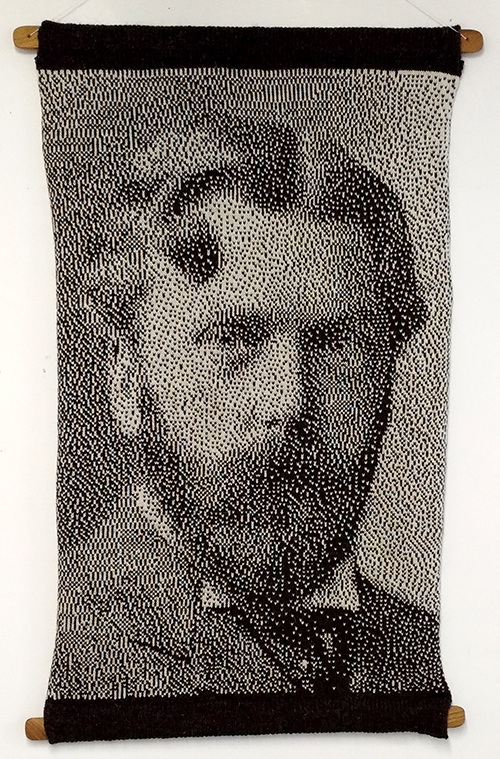
Knitted wall hanging of the young D’Arcy Wentworth Thompson by Madeleine Shepherd
In the autumn of 2016, Jo Macrae (NMS and Craft Reactor) and I examined 75 specimens, looking for common characteristics and significant differences. Over much tea and biscuits, we considered what the trees were made from, the techniques used, the branching structure, the colour, texture and other features of the surface.
A few specimens were in leaf or bearing fruit but most were not, so structure and surface were the place to start. A couple were “fossilized” (i.e. felted), one so distorted that full identification wasn’t possible. We also had a number of herbarium pages showing only the bark of small specimens.
The whole group was defined as the class Yarnia, all being constructed from yarn. This fell into two orders Crochetales and Knitales depending on construction stitch. Branching structures were used to classify trees at the genus level. Even binary branching and Fibonacci binary branching were present in both families. Additionally some specimens of Knitales exhibited triple branching structure. We therefore defined three genera within Knitales and two in Crochetales.
Having classified down to genus level, deciding what was a big enough difference to make something a new species was pretty tricky. We have used texture, stitch types, and different ways of colouring to separate specimens within each genus but think this may be open to further research by future scholars.
Naming the species offered an opportunity to mark the contributions of our “specimen collectors” around the world. Every tree has now been labelled and will be photographed. Even though the may not be attached to your own specimens, I hope most of you will recognise yourself in the dodgy Latin names we’ve come up with! All will be revealed in a future blog post to coincide with the still undefined exhibition(s). Watch this space or the Ravelry group (login required) for details.
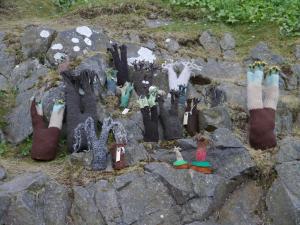
Binary Bonsai in the wild!
Since the Botanica Mathematica project started in 2013 we’ve had loads of contributions. Magnificent specimens of Binary and Trinary Bonsai, Fibonacci Trees, Hyperbolic Kelp and Chanterelles have all made their way to my studio in Edinburgh from around Europe and the USA.
But it’s not over yet!
If you wanted to make a tree (or another tree!) for the project you still can. We’ll be collecting Binary Bonsai and Fibonacci Trees over the summer before embarking on the classification of all of the trees. Once we have our lovely taxonomy and family tree of trees, we will be seeking to exhibit this final stage of the project in honour of the centenary of D’Arcy Thomson’s 1917 work, On Growth and Form. Although it focuses on animals rather than plants, this founding work of mathematical biology is a major inspiration behind Botanica Mathematica.
If you’re inspired by D’Arcy’s ideas too, please pick up your needles and hooks and make a tree. Details of where to send them are in the Binary Bonsai instructions or if you are in or around Edinburgh use the form below to contact Madeleine Shepherd to arrange delivery/pick up in person.
On Friday we installed a large chunk of Botanica Mathematica in Taypark House, Perth Road, Dundee for the Dundee Science Festival. It will be there for two weeks and we’ll be back in between to make a few changes and to run a workshop in Fluph Yarn Store. Details and links in the side bar.
The exhibition is in the large hallway of a Victorian mansion house that now houses a lovely cafe and bar. It’s installed in shelving and on the big chest at the entrance and looks very much at home. I think it looks like a collection the original owner might have assembled on his travels as a merchant.
Do go and see it and let us know what you think.
Last week I got chatting to Étienne Ghys, a wonderful French mathematician who was in Edinburgh showing us his new films about Chaos. We told him about Botanica Mathematica and he said “You could knit a Fibonacci tree!”.
And I thought, “Why haven’t we already knitted a Fibonacci tree??” The idea was so obvious and its execution so easy that it seemed silly not to have done so already. The Fibonacci pattern is also an excellent model for how plants actually grow, so it was perfect for the Botanica Mathematica project.
How does the Fibonacci model work? Well, you start with a branch, and after a certain period of time it splits into two smaller branches: a main one and a sapling. In the next time period the sapling stays the same size as it grows to adulthood, while the main branch once again splits into two. (We had a discussion of this in a previous post.) Here’s a picture of the resulting tree:
 The black numbers to the right indicate how many branches there are at each time step. This sequence of numbers is known as the Fibonacci sequence, and the next number is the sum of the previous two.
The black numbers to the right indicate how many branches there are at each time step. This sequence of numbers is known as the Fibonacci sequence, and the next number is the sum of the previous two.
The small blue numbers next to each branch indicate how wide the branch is – in knitting terms this is the number of stitches you are knitting with (in the round) for that branch.
So, start at the bottom of the tree by casting on 21 stitches. Join in the round and knit for 21 rows (the blue numbers also indicate the height of each branch!). Then put 8 of the stitches onto a stitch holder while you knit with the other 13 (joined in the round). After 13 rows, put 5 stitches onto a stitch holder while you knit (in the round) with the other 8, continuing in this way until you reach the top of the tree. Then go back to the last set of stitches being held, pick up the stitches and knit in the same way as before to the top of the tree. (It’s exactly the same technique as for the binary bonsai.)
There’s Fibonacci numbers everywhere in this tree: in the number of rows you do at each stage; in the size of each branch; and in the number of branches at each horizontal cross-section. The ratio of successive Fibonacci numbers gives (an approximation to) the golden ratio, and indeed the finished tree has a pleasing dimension and appearance to it. I think it looks more realistic than the binary bonsais.
Here’s a picture of my finished tree:
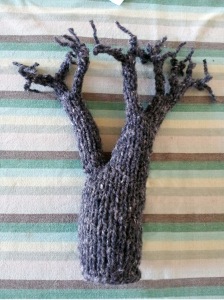 Do you like it? Do you have more ideas of what we could make, or ideas of how to adapt the Fibonacci tree? Let us know!
Do you like it? Do you have more ideas of what we could make, or ideas of how to adapt the Fibonacci tree? Let us know!

Botanica Mathematica at Coburg House Art Studios, August 2013
We’ve got a workshop set up for anyone who can make it to Edinburgh to knit trees with us. We’d really love to meet as many of our supporters as possible. All trees delivered to us by 31 March will go on display in the Science Festival Art Trail so this is an ideal chance to get started.
Date 15 March
Time 11am for a couple of hours
Location Summerhall Cafe, Summerhall Arts Centre, 1 Summerhall Place, Edinburgh (that’s a lot of Summerhall!) Here’s a map Summerhall is also the venue for the exhibition and hopefully by then we’ll know exactly where our work will be sited.
Julia and I will both be there with our big bag of wool (kindly donated by McAree Bros and by an anonymous knitter) to hand out. Bring your favourite dpns or crochet hook. We’ll give you the yarn and talk you through the process of making a binary bonsai that you can add to to the specimen collection for the exhibition in April. I’ll also have some felt and embroidery floss to get people making a stitched version. I haven’t had time to write up yet but it’s on its way. We’ll have tree stuffing stuff too!
Please spread the word. Tell members of your local knitting group. Bring/send along anyone who’s interested in contributing – basic knitting in the round or crochet skills required.
If you’ve made a tree or hyperbolic flowers or fungus this would be a good time and place to hand them in too.
Hope to see you there!
This morning the Edinburgh International Science Festival launched their programme.
We really pleased to announce that Botanica Mathematica will be part of the Science at the HeART of Things art trail. It will take place from 5th to 20th April in Edinburgh’s Summerhall Art Centre which has been getting lots of media attention for its adventurous programmes of exhibitions and performances.
I’d like to take this opportunity to ask knitter or crocheter who reads this to contribute a Binary Bonsai or a Fibonacci Flower or a Hyperbolic Chanterelle to help put on a really great show. In particular we need more trees to have a good sample size for species classifications. We could hold a workshop (with free yarn from our sponsors, McAree Bros 🙂 ) one Saturday in March if it looks like people are interested. Email madeleineshepherd[at]gmail.com (replacing [at] with @ – of course) if you’d like to come along and we’ll take it from there.
Botanica Mathematica will also be taking part in Botanics Late in the Royal Botanic Gardens Edinburgh on 17 April. For this event we’ll be showcasing the results of our new collaboration with Naomi Nakayama from Institute of Molecular Plant Sciences, University of Edinburgh. Naomi is helping us make new designs based on lichens, mosses, liverworts and other lower plants indigenous to Scotland. We’ll have more to say about these in the near future.
There’s also a Mini Maker Faire on 20 April at Summerhall. We will both be around in one capacity or another. More on this as it gets finalised.
I hope you’ll all be able to contribute to/take part in/visit these and other events during the Festival this April. Please share your thoughts and photographs if you do.
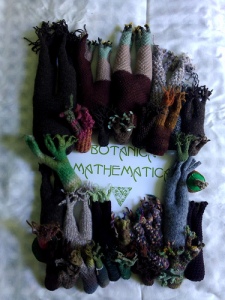 As we reach the end of 2013, it’s time to pause and take stock of all the wonderful things Botanica Mathematica has produced over the year. Join us at ICMS for a public lecture about the project, including the mathematical ideas behind the patterns, the classification of all the specimens we’ve been sent, and all the crazy directions that people have taken the project in!
As we reach the end of 2013, it’s time to pause and take stock of all the wonderful things Botanica Mathematica has produced over the year. Join us at ICMS for a public lecture about the project, including the mathematical ideas behind the patterns, the classification of all the specimens we’ve been sent, and all the crazy directions that people have taken the project in!
The talk is 6-7pm on Tuesday 10 December, at 15 South College Street. Tickets are free but limited, so book yours today at Eventbrite: https://botanica-mathematica.eventbrite.co.uk/. The event will be followed by drinks and mince pies, and a chance to see the full Botanica Mathematica collection.
This lecture is actually the third in a trilogy of talks celebrating Maths for Planet Earth. As this year draws to a close, we will be starting to think about 2014 and what new projects might be in store. 2014 will be the International Year of Crystallography and also the 400th anniversary of the invention of logarithms in Edinburgh by John Napier. Tell us what ideas you have for a new maths/textiles science communication project!